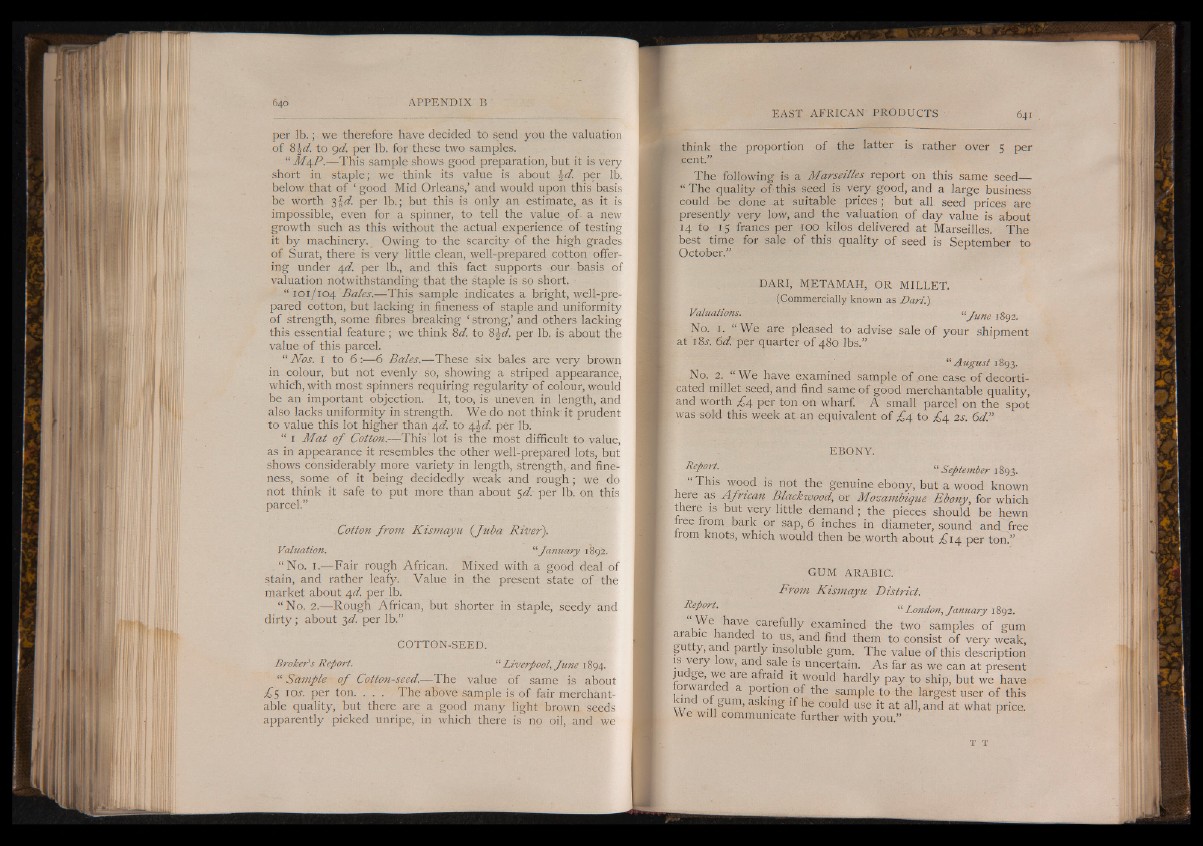
per lb .; we therefore have decided to send you the valuation
of 8 \d. to 9d. per lb. for these two samples.
“ M 4P.— This sample shows gpod preparation, but it is very
short in staple; we think its value is about \d. per lb.
below that of ‘ good Mid Orleans,’ and would upon this basis
be worth 3^d. per lb,; but this is only an estimate, as it; is
impossible, even for a spinner, to tell the value of- a new
growth such as this without the actual experience of testing
it by machinery. Owing to the scarcity of the high grades
of Surat, there is very little clean, well-prepared cotton offering
under 4d. per lb., and this- fact supports our basis of
valuation notwithstanding that the staple is so short.
“ 1011104 Bales.— This sample indicates a bright, well-prepared
cotton, but lacking in fineness of staple and uniformity
of strength, some fibres breaking ‘ strong,’ and others lacking
this essential feature ; we think 8d. to 8\d. per lb. is about the
value of this parcel.
“ Nos. 1 to 6:— 6 Bales.— These six bales are very brown
in colour, but not evenly so, showing a striped appearance,
which, with most spinners requiring regularity of colour, would
be an important objection. It, too, is uneven in length, and
also lacks uniformity in strength. We do not think' it prudent
to value this lot higher than 4d. to 4\d. per lb.
“ x Mat o f Cotton — This Tot is the most difficult to value,
as in appearance it resembles the other well-prepared lots, but
shows considerably more variety in length, strength, and fineness,
some of it being decidedly weak and rough; we do
not think it safe to put more than about 5d. per lb. on this
parcel.”
Cotton from Kismayu (Juba River).
Valuation. “ January 1892.
“ No. i.-— Fair rough African. Mixed with a good deal of
stain, and rather leafy. Value in the present state of the
market about 4d. per lb,
“ No. 2.— Rough African, but shorter in staple, seedy and
dirty; about 3d. per lb.”
COTTON-SEED.
Broker's Report. “ Liverpool, June 1894.
“ Sample o f Cotton-seed.— The value of same is about
£5 10s. per ton. . . . The above sample is of fair merchantable
quality, but there are a good many light brown seeds
apparently picked unripe, in which there is no oil, and we
think the proportion of the latter is rather over 5 per
cent.”
The following is a Marseilles report on this same seed—
“ The quality o f this seed is very good, and a large business
could be done at suitable prices; but all seed prices are
presently very low, and the valuation of day value is about
14 to 15 francs per 100 kilos delivered at Marseilles. The
best time for sale of this quality of seed is September to
October.”
DARI, METAMAH,. OR MILLET.
(Commercially known as Dari.)
Valuations. «j une ¡gg2i
No. i. We are pleased to advise sale of your shipment
at 1 8j. 6d. per quarter of 480 lbs.”
“ August 1893.
No. 2. “ We have examined sample of one case of decorticated
millet seed, and find same of good merchantable quality,
and worth £4 per ton on wharf. A small parcel on the spot
was sold this week at an equivalent of £4 to £4 2s. 6d.”
EBONY.
Report. - “ September 1893.
“ This wood is not the genuine ebony, but a wood known
here as African Blackwood, or Mozambique Ebony, for which
there is but very little demand; the pieces should be hewn
free from bark or sap, 6 inches in diameter, sound and free
from knots, which would then be worth about ^14 per ton.”
GUM ARABIC.
From Kismayu District.
eport. . “ London, January 1892.
We have carefully examined the two samples of gum
arable handed to us, and find them to consist of very weak,
gutty, and partly insoluble gum. The value of this description
is very low, and sale is uncertain. As far as we can at present
ju ge, we are afraid it would hardly pay to ship, but we have
orwarded a portion of the sample to the largest user of this
w Sum> asking if he could use it at all, and at what price.
We will communicate further with you.”
T T